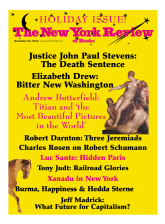In response to:
The Painter's Painter: Velázquez After 350 Years from the September 30, 2010 issue
To the Editors:
Willibald Sauerländer’s tribute to Diego Velázquez on the 350th anniversary of his death is perceptive but at several points I believe misleading [“The Painter’s Painter: Velázquez After 350 Years,” NYR, September 30]. The Velázquez exhibition at the London National Gallery in 2006–2007 made evident that the posthumous rediscovery of Velázquez began well before the French painter Édouard Manet’s celebrated homage or the German art historian Carl Justi’s biography in the second half of the nineteenth century.
Far from being “largely unknown outside of Spain,” as Sauerländer claims, Velázquez was certainly by then widely recognized as a master. Despite having been largely a painter for the Spanish king, with most of his work sequestered in the royal collection, his fame had spread particularly among British collectors and connoisseurs (as Xavier Bray points out in the National Gallery’s exhibition catalog)—among them Sir William Hamilton, envoy to Naples, and Lord Grantham, ambassador to Spain. Joshua Reynolds, visiting Rome, had already called the portrait of Innocent X the closest to truth of any work he’d seen. The Napoleonic Wars soon provided a chance for Velázquezes to be liberated, by British dealers and their agents, by generals both French and British. Wellington acquired a number of Velázquez canvases after the Battle of Vitoria and was allowed by Ferdinand VII to keep them because of the duke’s part in freeing Spain.
Consequently Wellington’s London home of Apsley House vies with the London National Gallery in possessing more paintings by Velázquez than any other museum outside the Prado—set up in 1819 by Ferdinand VII to house the royal pictures and thereafter giving people from both Spain and abroad an ample chance to get in touch with this allegedly remote yet most enchanting of painters.
Anthony Bailey
Mersea Island
Essex, England
Willibald Sauerländer replies:
Anthony Bailey is quite correct in recalling the early English interest in Velázquez, which I had overlooked in my general tribute to the master. As noteworthy as this distinguished reception of Velázquez has been, the discovery of Velázquez’s paintings as a model and catalyst for the “peintres de la vie moderne” remains a French affair and was mainly due to Édouard Manet.
This Issue
December 23, 2010



